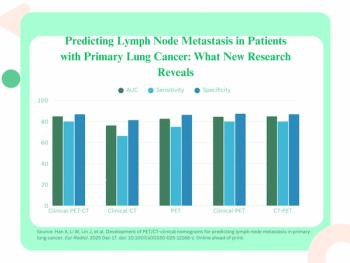
Study Emphasizes PSA and PSMA PET Tumor Volume Assessment for Predicting mHSPC Progression After Apalutamide and ADT
New research shows that over 94 percent of patients who had a PSA level of < 0.2 ng/mL and low-volume disease assessment six months after initiation of apalutamide and androgen deprivation therapy (ADT) for metastatic hormone-sensitive prostate cancer had radiographic progression-free survival at 24 months.
For patients treated with apalutamide and androgen deprivation therapy (ADT) for metastatic hormone-sensitive prostate cancer (mHSPC), those with a prostate-specific antigen (PSA) level and low-volume disease at six months were over 36 percent more likely to have radiographic progression-free survival (rPFS) at 24 months in comparison to those with an incomplete PSA response and high-volume disease.
For the multicenter retrospective study, recently published in
The study authors found that 65 percent of patients had a complete response (CR), defined as a PSA level of <0.2 ng/mL, at six months. These patients had a 21 percent higher prevalence of rPFS at 24 months (94 percent vs. 73 percent) and 36 months (81 percent vs. 60 percent) in comparison to patients who had an incomplete response (IR) to treatment (defined as a PSA level > 0.2 ng.mL) at six months, according to the researchers.
The researchers added that patients who achieved CR at six months were 62 percent more likely to have rPFS.
“The present study confirms that PSA response at 6 months is a robust predictor of radiographic progression in patients with mHSPC treated with apalutamide plus ADT in a real-world setting,” wrote lead study author Christian Andres Martinez Osorio, M.D., a urologist and assistant professor at the University of Chile in Santiago, Chile, and colleagues.
Noting that the differentiation of high-volume and low-volume disease can be a key criterion for treatment intensification, the researchers found that 94.1 percent of patients with low-volume disease and CR at six months achieved rPFS at 24 months.
In comparison, 80.4 percent of those with low-volume disease and IR had rPFS at 24 months. The study authors noted that 24-month rPFS occurred in 82.2 percent of those with high-volume disease and CR at six months, and in 57.4 percent of patients with high-volume disease and IR.
While PET CT was only employed in 59 percent of the cohort, the researchers pointed out that the modality offers key advantages over traditional imaging with bone scan and magnetic resonance imaging (MRI).
“PSMA PET has demonstrated superiority over conventional imaging in evaluating the spread of metastatic disease, allowing for precise differentiation between LV and HV disease, as well as subcategories like unifocal, oligometastatic, and disseminated disease. By quantifying PSMA‐positive tumor volume (PSMA‐TV), these advancements facilitate targeted or multimodal therapies, significantly improving the accuracy of mHSPC classification and management,” emphasized Osorio and colleagues.
(Editor’s note: For related content, see “
In regard to study limitations, the authors acknowledged the lack of standard imaging protocols for evaluating disease volume as well as the lack of a uniform follow-up schedule.
Newsletter
Stay at the forefront of radiology with the Diagnostic Imaging newsletter, delivering the latest news, clinical insights, and imaging advancements for today’s radiologists.




























